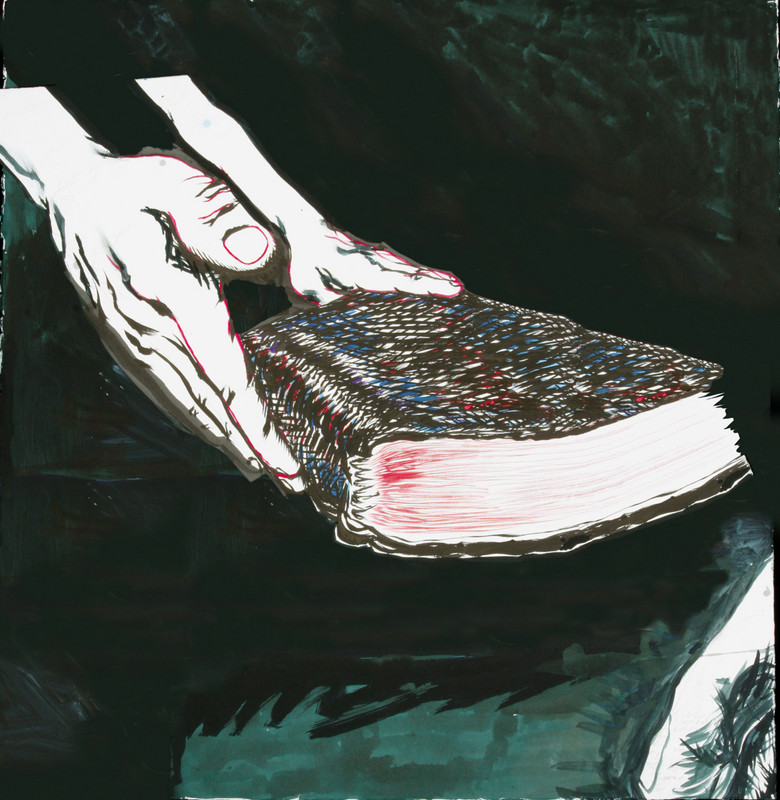Raymond Pettibon
03 Dec 2012 - 26 Feb 2013
RAYMOND PETTIBON
Sunday Night and Saturday Morning, 2005
3 December 2012 – February 2013
Projection on the outer wall of the museum
Raymond Pettibon’s work Sunday Night and Saturday Morning surprises the viewer with its aesthetics, which are somewhat unconventional for video art. Pettibon arranges his watercolors and ink drawings into a dense collage of moving images with sequential animation, coloration and seemingly ephemeral lines that are reminiscent of comics.
The integration of text – usually provided in comics by speech bubbles – is replaced here by spoken text whose content often generates a discrepancy between text and image. Some motifs, such as the black sun and the baby on the rescue net, occur more frequently but are underlaid with different sound tracks so that the scenes can be interpreted differently. The result is that Pettibon’s work does not seem funny and light like most comics. Its heterogeneous links and associations raise serious questions about society in general.
Pettibon obtains his inspiration from American culture, including film stars and comic heroes, politicians, news events, scenes from television and “film noir” as well as from literature by Henry James and John Ruskin. Personal experiences also play a role, such as Pettibon’s observations of surfers on California beaches.
Sunday Night and Saturday Morning, 2005
1-channel video, colour, sound
Duration: 16’ 45’’
Raymond Pettibon (born 1957 in Tucson, USA, lives and works in Hermosa Beach, USA).
He received his Bachelor of Fine Arts from UCLA (Los Angeles, California, USA) in 1977 after first studying business administration.
From 1977 on, Pettibon was a member of the punk rock band Panic (later known as Black Flag), which his brother Gregg Ginn had founded. In the 1980s, Pettibon’s renown grew increasingly because he designed logos, album covers and flyers for the band.
In 2002, the artist participated in the Documenta 11. In 2004, he won the Bucksbaum Award presented by the Whitney Biennial and in 2010 the Oskar Kokoschka Prize from the Austrian government.
The film is being shown parallel to the Roni Horn exhibit. It is projected on the outer facade of the museum building beginning at dark.
Sunday Night and Saturday Morning, 2005
3 December 2012 – February 2013
Projection on the outer wall of the museum
Raymond Pettibon’s work Sunday Night and Saturday Morning surprises the viewer with its aesthetics, which are somewhat unconventional for video art. Pettibon arranges his watercolors and ink drawings into a dense collage of moving images with sequential animation, coloration and seemingly ephemeral lines that are reminiscent of comics.
The integration of text – usually provided in comics by speech bubbles – is replaced here by spoken text whose content often generates a discrepancy between text and image. Some motifs, such as the black sun and the baby on the rescue net, occur more frequently but are underlaid with different sound tracks so that the scenes can be interpreted differently. The result is that Pettibon’s work does not seem funny and light like most comics. Its heterogeneous links and associations raise serious questions about society in general.
Pettibon obtains his inspiration from American culture, including film stars and comic heroes, politicians, news events, scenes from television and “film noir” as well as from literature by Henry James and John Ruskin. Personal experiences also play a role, such as Pettibon’s observations of surfers on California beaches.
Sunday Night and Saturday Morning, 2005
1-channel video, colour, sound
Duration: 16’ 45’’
Raymond Pettibon (born 1957 in Tucson, USA, lives and works in Hermosa Beach, USA).
He received his Bachelor of Fine Arts from UCLA (Los Angeles, California, USA) in 1977 after first studying business administration.
From 1977 on, Pettibon was a member of the punk rock band Panic (later known as Black Flag), which his brother Gregg Ginn had founded. In the 1980s, Pettibon’s renown grew increasingly because he designed logos, album covers and flyers for the band.
In 2002, the artist participated in the Documenta 11. In 2004, he won the Bucksbaum Award presented by the Whitney Biennial and in 2010 the Oskar Kokoschka Prize from the Austrian government.
The film is being shown parallel to the Roni Horn exhibit. It is projected on the outer facade of the museum building beginning at dark.

